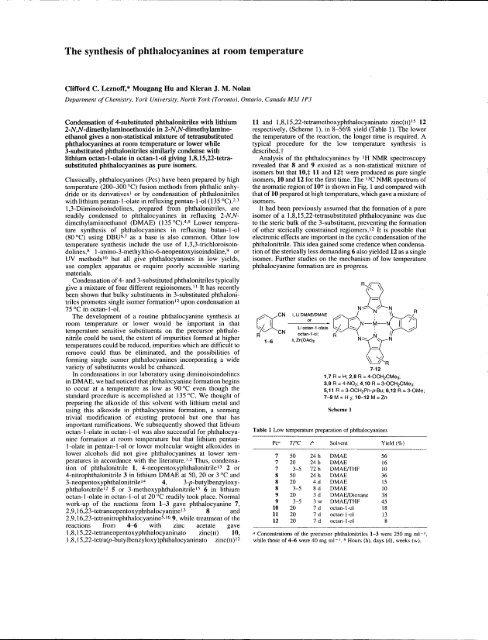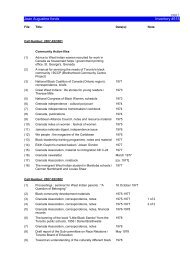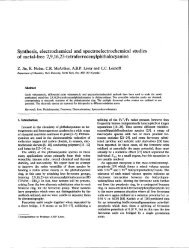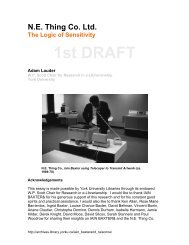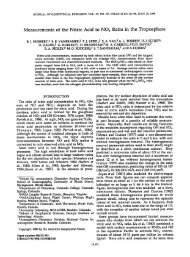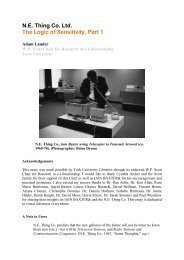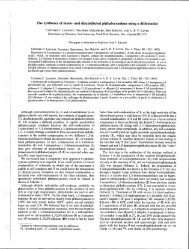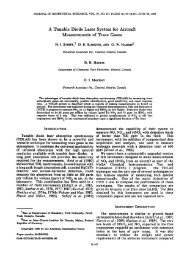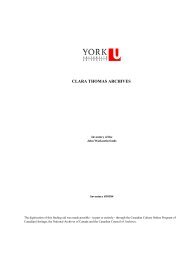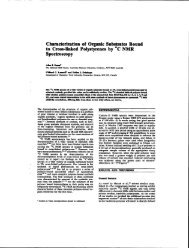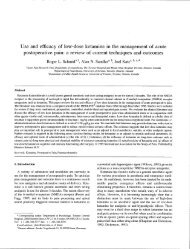The synthesis of phthalocyanines at room temperature ... - YorkSpace
The synthesis of phthalocyanines at room temperature ... - YorkSpace
The synthesis of phthalocyanines at room temperature ... - YorkSpace
You also want an ePaper? Increase the reach of your titles
YUMPU automatically turns print PDFs into web optimized ePapers that Google loves.
<strong>The</strong> <strong>synthesis</strong> <strong>of</strong> <strong>phthalocyanines</strong> <strong>at</strong> <strong>room</strong> temper<strong>at</strong>ure<br />
Clifford C. Lezn<strong>of</strong>f,* Mougang Hu and Kieran J. M. Nolan<br />
Department <strong>of</strong> Chemistry, York Universi1,, North York (Toronto), Ontario, Carcda M3J I P3<br />
Condens<strong>at</strong>ion <strong>of</strong> 4-substituted phthalonitriles with lithium<br />
2-N,N-dimethylaminoethoxide in 2-N,N-dimethylaminoethanol<br />
gives a non-st<strong>at</strong>istical mixture <strong>of</strong> tetrasubstituted<br />
<strong>phthalocyanines</strong> <strong>at</strong> <strong>room</strong> temper<strong>at</strong>ure or lower while<br />
3-substituted phthalonitriles similarly condense with<br />
lithium octan-l-ol<strong>at</strong>e in octan-1-ol giving 1,8,15,22-tetrasubstituted<br />
<strong>phthalocyanines</strong> as pure isomers.<br />
Classically, <strong>phthalocyanines</strong> (Pcs) have been prepared by high<br />
temper<strong>at</strong>ure (200-300'C) fusion methods from phthalic anhydride<br />
or its deriv<strong>at</strong>ivesr or by condens<strong>at</strong>ion <strong>of</strong> phthalonitriles<br />
with lithium pentan-l-ol<strong>at</strong>e in refluxing pentan-1-ol (135 "C;.2.:<br />
1,3-Diiminoisoindolines, prepared from phthalonitriles, are<br />
readily condensed to <strong>phthalocyanines</strong> in refluxing 2-N,Ndimethylaminoethanol<br />
(DMAE) (135 "C).4.5 Lower temper<strong>at</strong>ure<br />
<strong>synthesis</strong> <strong>of</strong> <strong>phthalocyanines</strong> in refluxing butan-l-ol<br />
(80 "C) using DBU6.7 as a base is also common. Other low<br />
temper<strong>at</strong>ure <strong>synthesis</strong> include the use <strong>of</strong> 1,3,3+richloroisoindolines,s<br />
l-imino-3-methylthio-6-neopentoxyisoindoline,e or<br />
UV methodsro but all give <strong>phthalocyanines</strong> in low yields,<br />
use complex appar<strong>at</strong>us or require poorly accessible starting<br />
m<strong>at</strong>erials.<br />
Condens<strong>at</strong>ion <strong>of</strong> 4- and 3-substituted phthalonitriles typically<br />
give a mixture <strong>of</strong> four ditferent regioisomers.t t It has recently<br />
been shown th<strong>at</strong> bulky substituents in 3-substituted phthalonitriles<br />
promotes single isomer form<strong>at</strong>ionl2 upon condens<strong>at</strong>ion al<br />
75 oC in octan-l-ol.<br />
<strong>The</strong> development <strong>of</strong> a routine phthalocyanine <strong>synthesis</strong> <strong>at</strong><br />
<strong>room</strong> temper<strong>at</strong>ure or lower would be important in th<strong>at</strong><br />
temper<strong>at</strong>ure sensitive substituents on the precursor phthalonitrile<br />
could be used, the extent <strong>of</strong> impurities formed <strong>at</strong> higher<br />
temper<strong>at</strong>ures could be reduced, impurities which are difficult to<br />
remove could thus be elimin<strong>at</strong>ed, and the possibilities <strong>of</strong><br />
forming single isomer <strong>phthalocyanines</strong> incorpor<strong>at</strong>ing a wide<br />
variety <strong>of</strong> substituents wouid be enhanced.<br />
In condens<strong>at</strong>ions in our labor<strong>at</strong>ory using diminoisoindolines<br />
in DMAE, we had noticed th<strong>at</strong> phthalocyanine form<strong>at</strong>ion begins<br />
to occur <strong>at</strong> a temper<strong>at</strong>ure as low as 90 oC even though the<br />
standard procedure is accomplished <strong>at</strong> 135 "C. We thought <strong>of</strong><br />
preparing the alkoxide <strong>of</strong> this solvent with lithium metal and<br />
using this alkoxide in phthalocyanine form<strong>at</strong>ion, a seeming<br />
trivial modific<strong>at</strong>ion <strong>of</strong> existing protocol but one th<strong>at</strong> has<br />
important ramific<strong>at</strong>ions. We subsequently showed th<strong>at</strong> lithium<br />
octan- I -ol<strong>at</strong>e in octan- l -ol was also successful for phthalocyanine<br />
form<strong>at</strong>ion <strong>at</strong> <strong>room</strong> temper<strong>at</strong>ure but th<strong>at</strong> lithium pentanl-ol<strong>at</strong>e<br />
in pentan'l-ol or lower molecular weight alkoxides in<br />
lower alcohols did not give <strong>phthalocyanines</strong> <strong>at</strong> lower temper<strong>at</strong>ures<br />
in accordance with the liter<strong>at</strong>ure.l'2 Thus, condens<strong>at</strong>ion<br />
<strong>of</strong> phthalonitrile 1, 4-neopentoxyphthalonitriler3 2 or<br />
4-nitrophthaloninile 3 in lithium DMAE <strong>at</strong> 50, 20 or 3 "C and<br />
3-neopentoxyphthalonitrilera 4, 3-p-butylbenzyloxyphthalonitriler2<br />
5 or 3-methoxyphthalonitriler5 6 in lithium<br />
octan- I -ol<strong>at</strong>e in octan- I -ol <strong>at</strong> 20 "C readily took place. Normal<br />
work-up <strong>of</strong> the reactions from l-3 gave phthalocyanine 7,<br />
2,9,16,23-tetraneopentoxyphthalocyaniner3 8 and<br />
2,9, | 6,23 -tetr anitro<strong>phthalocyanines</strong>' I 6 9, while tre<strong>at</strong>ment <strong>of</strong> the<br />
reactions from 44<br />
with zinc acet<strong>at</strong>e gave<br />
1,8,15,22-tetraneopentoxyphthalocyanin<strong>at</strong>o zinc(u) 10,<br />
1,8, 15,22-tetra(p-butylbenzyloxy)phthalocyanin<strong>at</strong>o zinc(u)r2<br />
11 and 1,8, I 5,22-tetramethoxyphthalocyanin<strong>at</strong>o zinc(u) rs 12<br />
respectively, (Scheme 1), in 8-567o yield (Table 1). <strong>The</strong> lower<br />
the temper<strong>at</strong>ure <strong>of</strong> the reaction, the longer time is required. A<br />
typical procedure for the low temper<strong>at</strong>ure <strong>synthesis</strong> is<br />
described.t<br />
Analysis <strong>of</strong> the <strong>phthalocyanines</strong> by tH NMR spectroscopy<br />
revealed th<strong>at</strong> 8 and 9 existed as a non-st<strong>at</strong>istical mixture <strong>of</strong><br />
isomers but th<strong>at</strong> 10,* ll and l2f were produced as pure single<br />
isomers, l0 and 12 for the first time. <strong>The</strong> r3C NMR spectrum <strong>of</strong><br />
the arom<strong>at</strong>ic region <strong>of</strong> 10f is shown in Fig. 1 and compared with<br />
th<strong>at</strong> <strong>of</strong> l0 prepared <strong>at</strong> high temper<strong>at</strong>ure, which gave a mixture <strong>of</strong><br />
tsomers.<br />
It had been previously assumed th<strong>at</strong> the form<strong>at</strong>ion <strong>of</strong> a pure<br />
isomer <strong>of</strong> a 1,8,15,Z2-tetrasubstituted phthalocyanine was due<br />
to the steric bulk <strong>of</strong>the 3-substituent, preventing the form<strong>at</strong>ion<br />
<strong>of</strong> other sterically constrained regiomers.12 It is possible th<strong>at</strong><br />
electronic effects are important in the cyclic condens<strong>at</strong>ion <strong>of</strong>the<br />
phthalonitrile. This idea gained some credence when condens<strong>at</strong>ion<br />
<strong>of</strong> the sterically less demanding 6 also yielded 12 as a single<br />
isomer. Further studies on the mechanism <strong>of</strong> low temper<strong>at</strong>ure<br />
phthalocyanine form<strong>at</strong>ion are in progress.<br />
aY",<br />
i,LipMAE/pMAE_<br />
Ya.\^-,<br />
R "'' @ian'1-ol;<br />
!_S<br />
ii, Zn(OAc)a<br />
Liocran-l-ol<strong>at</strong>e<br />
7-12<br />
1,7 R = H; 2,8 R = 4-OCHzCMes;<br />
3,9 R = 4-NOz; 4,10 R = 3-OCHzCMeg;<br />
5'11 F = 3-OCH2Ph-PBU; 6,12 R = 3-OMe;<br />
7-9M=He;10-12M=Zn<br />
Scheme I<br />
Table I Low temper<strong>at</strong>ure prepar<strong>at</strong>ion <strong>of</strong> phthalmyanines<br />
750<br />
720<br />
7 3-5<br />
850<br />
820<br />
8 3-5<br />
920<br />
9 3-5<br />
l0 20<br />
ll z0<br />
z0<br />
t2<br />
TfC Solvent Yield (7o)<br />
24h DMAE<br />
24h DMAE<br />
72h DMAE/|HF<br />
24h DMAE<br />
4d DMAE<br />
8 d DMAE<br />
3 d DMAE/Dioxane<br />
3 w DMAE/IHF<br />
'7 d octan-l-ol<br />
7 d octan-l-ol<br />
7 d oclan-l-ol<br />
56<br />
t6<br />
l0<br />
36<br />
l-)<br />
l0<br />
38<br />
45<br />
l8<br />
t3<br />
8<br />
" Concentr<strong>at</strong>ions <strong>of</strong> the precursor phthalonitriles l-3 were 250 mg ml -<br />
t<br />
while those <strong>of</strong> 4-6 were 40 mg ml - r. b Hours (h), days (d), weeks (w).
160<br />
140<br />
6<br />
140<br />
6<br />
120<br />
120<br />
f S<strong>at</strong>isfactory spectroscopic d<strong>at</strong>a were obtained for all compounds and<br />
elemental analysis for the new single isomers l0 and 12. Selected<br />
spectroscopic d<strong>at</strong>a for l0: UV-VIS (THF) i"*."/nm (log e) 698 (5.24),662<br />
(4.30),622(4.26) and 365 (4. I 2): IR v/cm- t (KBr) 3010, 2920, 2840,2820,<br />
157-5, 1480, 1335, 1255, 1230, I r30. 1090, 1060, t040, 1020,800.760 and<br />
73S; t11 11"* (400 MHz, [rH.r]pyridine) 6 9.72 (d, 4 H, ! 7.4 Hz), 8.34 (t,<br />
4 H, J 7.4 Hz), 7.76 (d, 4 H, "I<br />
7.8 Hz), 4.37 (s, 8 ll) and 1.72 (s, 36 H): t:C<br />
NMR(100.6MHz [2HsJpyridine) 6 158.10, 154.97, 154.73, 142.85, 132.00,<br />
126.47, t16.90, 113.25, 19.70,33.32 and,27.35; FAB-MS tbr<br />
C52H56N3OaZn n/z (rel<strong>at</strong>ive inrensiry, 7o) 92O (l'/l+, 100). For 12: UV-VIS<br />
(THF) l'-",/nm (log e) 694 (5.2a',,662 (4.37),62 (4.43) and 368 (4.37); JR<br />
v/cm- | (KBr) 30 I 0, 2920, 2840. 2820, I 57.5, I 480, | 33 5, 1262, I 230, I I 30,<br />
1090, 1060, 1040. 1020. 800. 760 and 735; rH NMR (400 MI-lz,<br />
[,H5]pyridine) 6 9.55 (d, 4 H, J 8.0 Hz), 8.18 (r, 4 H, J 8.0 Hz), 7.69 (d,4<br />
H, J 7.9 Hz) and 4.58 (s, 8 H;; ttg NMR (100.6 MHz [2H5]pyridine) 6<br />
I 56.85, 155.07, 154.89. L42.93, 132.03, 127.04, I I 7.24, I I 3.8 I and 56.88:<br />
FAB-MS for Cj6H2aNsOaZn mlz (rel<strong>at</strong>ive intensity, 7o) 696 (l..{.t, l$).<br />
r55<br />
6<br />
Fig. I l3C NMR spectra <strong>of</strong> the arom<strong>at</strong>ic region <strong>of</strong> the pure isomer,<br />
1,8,15,22-tetranmpentoxyphthalocyanine l0 (top) (only two N-C-N<br />
carbon absorptions ar 6 154.97 and, 154.73: <strong>of</strong> I0 as a mixture <strong>of</strong><br />
regioisomers (middle); <strong>of</strong> the intemal N-C-N carbon absorptions <strong>of</strong> l0 as<br />
a mixture <strong>of</strong>regioisomers (bottom). Pyridine absorptions rccur <strong>at</strong> 6 150.35,<br />
I35.91 and I23.87.<br />
<strong>The</strong> authors acknowledge the N<strong>at</strong>ural Sciences and Engineering<br />
Research Council <strong>of</strong> Canada for financial support.<br />
Footnotes<br />
f A suspension <strong>of</strong> 0.02 g <strong>of</strong> lithium in 3.0 ml <strong>of</strong> octan-l-ol w6 he<strong>at</strong>ed to<br />
170 "C and stined until a homogeneous solution was obtained. <strong>The</strong> solution<br />
was cooled to 20 oC and 150 mg <strong>of</strong> 4 in I ml <strong>of</strong> THF was added. <strong>The</strong> nrixture<br />
was stiffed for 7-10 d, after which excess zinc acet<strong>at</strong>e was added and the<br />
mixture stined ftrr another 2-3 d. <strong>The</strong> reaction was quenched with methanol<br />
and w<strong>at</strong>er (l:l) and washed with methanol. <strong>The</strong> crude products were<br />
purified by column chrom<strong>at</strong>ography on silica gel and l0 was obtained as a<br />
blue solid in l87o yield. Recrystalliz<strong>at</strong>ion <strong>of</strong> l0 tiom benzene gave blue<br />
needles.<br />
154<br />
References<br />
I C. C. lczn<strong>of</strong>f, in Phthalocyanines: Properties and Applicutions.<br />
ed. C. C. kzn<strong>of</strong>f and A. B. P. Lever, VCH. New York, 1989, p. l; F. H.<br />
Moser and A. L. Thomas, <strong>The</strong> Phthaloc)'aninas, vol. l, 2, CRC, Boca<br />
R<strong>at</strong>on. 1983-<br />
2 R. P. Linstead and A. R. Lowe, J. C hem. Soc., 1934. 1O22.<br />
3 N. B. McKeown, I. Chambrier and M. J. Cook, J. Chem. Soc., Pukin<br />
Trsns. l. 1990. 1169.<br />
4 J. A. Elvidge and R. P. Linstead, -/. Chem. Soc., 1955, 3536.<br />
5 P. J. Brach, S. J. Gramm<strong>at</strong>ica, O. A. Ossanna md L. Weinbergcr,<br />
J. Heterocyclic Chem., 1970. 7. 1403.<br />
6 H. Tomoda, S. Saito, S. Ogarva and S. Shiraishi, Chem. Lex' 1980.<br />
1277.<br />
7 T. G. Linssen, K. Dtin, M. Hanack and A. Hirsch, J. Chem. Soc., Chem.<br />
Commun.. 1995. 103.<br />
8 E. M. Idetson. US PAT., 1971,4061 654t Chem. Abstr., 1977,88.<br />
17l797mi J. G. Young and W. Onyebuagu, J. Org. Chem.. 1990, 55,<br />
2155.<br />
9 S. Greenberg, A. B. P. l*ver and C. C. Lezn<strong>of</strong>f, Can. J. Chem., 1988,<br />
66, 1059.<br />
l0 H. Tomoda, S. Saito and E. Hibiya, Chem. Lett.,1976, 1003.<br />
1 I D. Wdhrle, J. Gitzel, I. Okuro and S. Aono, l. C hem. Soc., P e rkin Trans<br />
2, 1985,l17l; M. Hanack, D. Meng, A. Beck, M. Sommeraur and L, R.<br />
Subramanian,J. Chem. Soc.,Chem. Commun.,1993,58; M. Hanack, G.<br />
Schmid and M. Sommerauer, Angev,. Chem., Int. Ed. Engl., 1993,32,<br />
1422.<br />
12 C. C. Lezn<strong>of</strong>f, M. Hu, C. R. McArthur, Y. Qin and J. E. van Lier, Ccr.<br />
J. Chem., 1994, 72, 1990.<br />
l3 C. C. tczn<strong>of</strong>f, S. M. Marcuccio, S. Greenberg, A- B- P. l:ver and K. B.<br />
Tomer, Can. J. Chem.,1985, 63, 623.<br />
14 C. C. Lezn<strong>of</strong>f md D. M. Drew, Can. J. C hem' 1996, 76, 3O7.<br />
l-5 V- M. Derkacheva, O. L- Kaliya and E. A. Luk'yanets, Zh. Obshch.<br />
Kiin., 1983,53, 188.<br />
l6 S. W. Oliver and T. D. Smith, J. Chem. Soc., PerkinTrans.2, 1987,<br />
1579.
Synthesis and NMR Studies <strong>of</strong> a Single lsomer <strong>of</strong> an<br />
Alkynyl Substituted Binuclear Phthalocyanine<br />
HIROAKI ISAGOT, DMITRI S. TEREKHOV and CLIFFORD C. LEZNOFF*<br />
Department <strong>of</strong> Chemistry, York University, North York (Tbronto), ON M3l 1P3, Canada<br />
ABSTRACT: By a mixed condens<strong>at</strong>ion <strong>of</strong> 1,3-bis(3',4'-dicyanophenory)-2-ethyl-2-methylpropane with a<br />
large amount <strong>of</strong> 4,5-bis(3,3-dimethyl-1-butynyl)phthalonitrile, 1,3-bis-2'-(9',10',16',17',23',zf'-hexakis<br />
(3",3"-dimethyl-1"-butynyl)phthalocyaninoxyl)-2-ethy1-2-methylpropane, was synthesized as a binuclear<br />
phthalocyanine having a single isomer. NMR studies <strong>at</strong> various temper<strong>at</strong>ures and concentr<strong>at</strong>ions suggested<br />
th<strong>at</strong> the interactions between the phthalocyanine macrocycles were domin<strong>at</strong>ed by intermolecular<br />
aggreg<strong>at</strong>ion <strong>at</strong> lower temper<strong>at</strong>ures or high concentr<strong>at</strong>ions whereas intramolecular aggreg<strong>at</strong>ion was<br />
predominant <strong>at</strong> higher temper<strong>at</strong>ures or lower concentr<strong>at</strong>ions. @ 1997 byJohnWiley & Sons, Ltd.<br />
l.<br />
7)<br />
Porphyrins Phthalocyanines, Vol. l, 135-140 (1997) (No. <strong>of</strong>figures:5 No. <strong>of</strong>tables:0 No. <strong>of</strong>refs:<br />
KEYWORDS: binuclear; phthalocyanine; intramolecular interactions<br />
INTRODUCTION<br />
Aggreg<strong>at</strong>ion is a well-known phenomenon in phthalocyanine<br />
(Pc) chemistry [1]. Interactions can occur<br />
between adjacent phthalocyanine macrocycles in<br />
media, resulting in coupling between the electronic<br />
st<strong>at</strong>es <strong>of</strong> more than one phthalocyanine nucleus.<br />
Binuclear <strong>phthalocyanines</strong> have <strong>at</strong>tracted much<br />
<strong>at</strong>tention as a probe for examining the degree <strong>of</strong><br />
intramolecular interaction and the extent <strong>of</strong> electronic<br />
coupling between the two macrocycles <strong>of</strong> the<br />
binuclear molecule. Binuclear <strong>phthalocyanines</strong> may<br />
be important in designing multi-electron redox<br />
c<strong>at</strong>alysts for electroc<strong>at</strong>alytic [2] and photoc<strong>at</strong>alytic<br />
processes and studying energy transfer in biological<br />
systems.<br />
Although a number <strong>of</strong> binuclear <strong>phthalocyanines</strong>,<br />
linked by bridges <strong>of</strong> different length, have been<br />
reported so far [3], they were mixtures <strong>of</strong> regioisomers,<br />
the presence <strong>of</strong> which have made the<br />
interpret<strong>at</strong>ions <strong>of</strong> the observed physical or physicochemical<br />
properties more difficult [4]. Known<br />
binuclear <strong>phthalocyanines</strong> th<strong>at</strong> were prepared have<br />
This paper is dedic<strong>at</strong>ed to Pr<strong>of</strong>, Dr. Michael Hanack on the<br />
occasion <strong>of</strong> his 65th birthday<br />
tA visiting scholar from the N<strong>at</strong>ional Research Institute for<br />
Metals, 1-2-1, Sengen, Tsukuba, Ibaraki 305 Japan.<br />
*Correspondence to: C. C. Lezn<strong>of</strong>f.<br />
only one substituent on each peripheral benzene ring<br />
to improve their solubility in organic solvents, useful<br />
for physical or physicochemical measurements.<br />
In this paper, we wish to report the <strong>synthesis</strong> <strong>of</strong> a<br />
binuclear phthalocyanine which is highly soluble in<br />
common organic solvents and forms only one isomer.<br />
Isol<strong>at</strong>ion <strong>of</strong> a single isomer binuclear Pc<br />
enabled us to study in more detail the NMR<br />
spectroscopy <strong>of</strong> the binuclear phthalocyanine for the<br />
first time. Monitoring <strong>of</strong> inter- and intramolecular<br />
interactions between phthalocyanine macromolecules<br />
by NMR spectroscopy is reported.<br />
RESULTS AND DISCUSSION<br />
Mixed condens<strong>at</strong>ion <strong>of</strong> 1,3-bis(3',4'-dicyanophenoxy)-2-ethyl-2-methylpropane,<br />
(l), with a 20-fold<br />
excess <strong>of</strong> 4,5-bis (3',3' -dimethyl- l' -butynyl) phthalonitrile,<br />
(2) [5] with lithium l-pentoxide in l-pentanol<br />
<strong>at</strong> 100'C gave the binuclear metal-free phthalocyanine,<br />
1,3-bis-2'- (9', 1 0',16',17',23',24-hexakis (3 ",3 " -<br />
dimethyl- 1 " -butynyl) phthalocyaninoxy) -2-ethyl-<br />
2-methylpropane (3) in 3.5o/" yield (Scheme 1).<br />
Mononuclear metal-free 2,3,9, 10, I 6, 1 7,23,Z4-octakis(3',3'-dimethyl-l'-butynyl)phthalocyanine<br />
(4)<br />
(hereafter referred to as mononuclear phthalocyanine),<br />
which formed as a by-product, had to be
emoved to purify the desired binuclear<br />
phthalocyanine.<br />
As 4 is less soluble in tetrahydr<strong>of</strong>uran (THF) than<br />
3, the desired binuclear phthalocyanine was effectively<br />
concentr<strong>at</strong>ed into THF solution from the<br />
reaction mixture. Attempts to separ<strong>at</strong>e the <strong>phthalocyanines</strong><br />
from each other by gel perme<strong>at</strong>ion<br />
chrom<strong>at</strong>ography (GPC) were unsuccessful because<br />
<strong>of</strong> poor resolution, maybe due to aggreg<strong>at</strong>ion phenomena.<br />
<strong>The</strong> best separ<strong>at</strong>ion was achieved by flash<br />
chrom<strong>at</strong>ography when it was performed on a small<br />
scale (less than 200 mg). <strong>The</strong> chrom<strong>at</strong>ographic<br />
separ<strong>at</strong>ion on a large scale ( > 500 mg) was unsuccessful<br />
because <strong>of</strong> the rel<strong>at</strong>ively low solubility <strong>of</strong> 4 in<br />
the solvent system (tolueneftrexane 1:1) used as an<br />
eluent. As expected, the binuclear phthalocyanine<br />
obtained in this way was pure and composed <strong>of</strong> only<br />
one isomer, as was shown by its NMR spectrum. <strong>The</strong><br />
NMR spectrum <strong>of</strong> 3 is characteristic <strong>of</strong> a heptasubstituted<br />
Pc.<br />
<strong>The</strong> electronic absorption spectrum <strong>of</strong> the binuclear<br />
phthalocyanine 3 in benzene is shown in Fig. 1.<br />
A quite broad absorption band was observed in the<br />
600-700 nm region with an absorption maximum <strong>at</strong><br />
698 nm. Dilution <strong>of</strong> the solution did not exhibit any<br />
changes in its spectral p<strong>at</strong>terns. Although the known<br />
mononuclear metal-free <strong>phthalocyanines</strong> show a<br />
pair <strong>of</strong> sharp Q-bands in the same region [4, 6], this<br />
is not the case for 3. However, it is understandable if<br />
a closed clam-shell conform<strong>at</strong>ion is assumed within a<br />
molecule because <strong>of</strong> a strong exciton coupling<br />
between the two chromophores <strong>of</strong> the Pc nucleii [4].<br />
An altern<strong>at</strong>ive possibility th<strong>at</strong> the binuclear phthalocyanine<br />
molecules aggreg<strong>at</strong>e to each other even in<br />
cH3(cHr4oli<br />
cH3(cHr4oH<br />
2 R=tert{uWl<br />
H.N<br />
+4<br />
R = tcrt-butyl<br />
Scheme 1.
Fig. 1. An electronic absorption spectrum <strong>of</strong> the<br />
binuclear phthalocyanine 3 in benzene solution.<br />
this concentr<strong>at</strong>ion range (10-5 mol l-r) is successfully<br />
elimin<strong>at</strong>ed by the NMR studies described below.<br />
Typical NMR spectra <strong>of</strong> binuclear metal-free<br />
phthalocyanine 3 in benzene-d6 are shown in Fig. 2.<br />
Although the spectra observed varied regularly<br />
depending on the temper<strong>at</strong>ure and concentr<strong>at</strong>ion <strong>of</strong><br />
the solutions used for the measurements (better<br />
resolution was obtained either <strong>at</strong> a higher temper<strong>at</strong>ure<br />
or with a lower concentr<strong>at</strong>ion <strong>of</strong> the<br />
solution used), their spectral aspects were essentially<br />
the same: six singlets, two doublets and one multiplet<br />
were observed in the arom<strong>at</strong>ic region (some signals<br />
overlapped with each other under some conditions)<br />
(Fig. 2a); and six singlets (<strong>at</strong>tributable to ferf-butyl<br />
protons), one singlet (methyl protons <strong>of</strong> the methyl<br />
group in the bridge) and one triplet (methyl protons<br />
<strong>of</strong> the ethyl group in the bridge) in an aliph<strong>at</strong>ic<br />
region (some signals overlapped with each other in<br />
some conditions) (Fig. 2b); and one AA'BB' p<strong>at</strong>tern<br />
multiplet <strong>at</strong>tributable to -OCH2- prochiral protons<br />
in the 4.0-4.5 ppm region (Fig. 2c); and one singlet<br />
<strong>at</strong>tributable to the inner protons in the -2.0 to -3.5<br />
ppm range (Fig. 2d). <strong>The</strong>se d<strong>at</strong>a are consistent with<br />
the desired structure <strong>of</strong> the binuclear metal-free<br />
phthalocyanine because the six protons on the<br />
benzene rings and the six lerFbutyl groups in the<br />
three, 4,5-dialkynylbenzo moieties are all different in<br />
the binuclear phthalocyanine 3 because <strong>of</strong> the<br />
presence <strong>of</strong> the seventh bridging group. Although no<br />
signal <strong>of</strong> the methylene protons <strong>of</strong> the ethyl group <strong>of</strong><br />
the bridging group was observed, its COESY spectrum<br />
clearly showed the presence <strong>of</strong>strong coupling<br />
between the triplet signals and some signals hidden<br />
by one <strong>of</strong> the intense /erl-butyl protons. <strong>The</strong> COESY<br />
spectrum also showed the presence <strong>of</strong> coupling<br />
between the doublet <strong>at</strong> around 7.5 ppm and the<br />
multiplet <strong>at</strong> around 8.0 ppm in the arom<strong>at</strong>ic<br />
region.<br />
As st<strong>at</strong>ed above, the NMR spectra showed both<br />
temper<strong>at</strong>ure and concentr<strong>at</strong>ion dependence. Figure<br />
3a and b show the concentr<strong>at</strong>ion dependence <strong>of</strong> the<br />
chemical shifts <strong>of</strong> the inner imino protons and some<br />
<strong>of</strong> the arom<strong>at</strong>ic protons <strong>of</strong> the binuclear phthalocyanine<br />
in benzene-d6 solutions. Although the signal<br />
shifted downfield in the high concentr<strong>at</strong>ion region<br />
(10-2-t0-n mol l-t) as the concentr<strong>at</strong>ion was lowered,<br />
it remained unchanged in the low concentr<strong>at</strong>ion<br />
region (10 a-10-6 mol l-t). In the previous paper [5],<br />
it was reported th<strong>at</strong> the chemical shifts <strong>of</strong> both the<br />
inner and arom<strong>at</strong>ic protons <strong>of</strong> mononuclear octaalkynyl-substituted<br />
<strong>phthalocyanines</strong> shifted downfield<br />
as their concentr<strong>at</strong>ion was lowered. <strong>The</strong>se shifts have<br />
been successfully explained in terms <strong>of</strong> aggreg<strong>at</strong>ion<br />
phenomena <strong>of</strong> phthalocyanine macrocycles [1,5].<br />
However, no such s<strong>at</strong>ur<strong>at</strong>ion phenomena against<br />
varied concentr<strong>at</strong>ion was observed for any mononuclear<br />
<strong>phthalocyanines</strong>. <strong>The</strong>refore, the s<strong>at</strong>ur<strong>at</strong>ion<br />
phenomenon is <strong>at</strong>tributed to some preferred c<strong>of</strong>acial<br />
conform<strong>at</strong>ion <strong>of</strong> the binuclear phthalocyanine in<br />
solution.<br />
A similar s<strong>at</strong>ur<strong>at</strong>ion phenomenon was observed<br />
when a nitrobenzene-d5 solution containing the<br />
binuclear phthalocyanine was he<strong>at</strong>ed up to 420 K<br />
(Fig. ). Although the inner protons did not show a<br />
clear s<strong>at</strong>ur<strong>at</strong>ion up to 420 K, the chemical shift seems<br />
close to s<strong>at</strong>ur<strong>at</strong>ion around -2 pp-, the value <strong>of</strong><br />
which is much lower than those <strong>of</strong> the known<br />
mononuclear <strong>phthalocyanines</strong> [5].<br />
Thus, both the concentr<strong>at</strong>ion- and temper<strong>at</strong>uredependence<br />
studies showed th<strong>at</strong> the chemical shifts<br />
<strong>of</strong> the protons in binuclear phthalocyanine 3 reach<br />
constant chemical shift values much earlier than the<br />
known rel<strong>at</strong>ed mononuclear <strong>phthalocyanines</strong>. <strong>The</strong>se<br />
phenomena are r<strong>at</strong>ionalized by assuming two types<br />
<strong>of</strong> interaction between the phthalocyanine macrocycles;<br />
one is an intermolecular interaction between<br />
a phthalocyanine macrocycle in a molecule and th<strong>at</strong><br />
in other molecules, and another is an intramolecular<br />
interaction between the two macrocycles within a<br />
molecule. In a highly concentr<strong>at</strong>ed solution, binuclear<br />
phthalocyanine molecules are close to each<br />
other and hence columns <strong>of</strong> aggreg<strong>at</strong>ed phthalocyanine<br />
macrocycles would be present in such a solution<br />
[5]. Dilution <strong>of</strong> such a solution will lengthen the<br />
distance between <strong>phthalocyanines</strong> and hence reduce<br />
the length <strong>of</strong> columns. Raising the temper<strong>at</strong>ure
would yield the same effects on the aggreg<strong>at</strong>ed<br />
<strong>phthalocyanines</strong> because thermal motion <strong>of</strong> the<br />
<strong>phthalocyanines</strong> would break such columns and<br />
hence shorten their length. <strong>The</strong> effects <strong>of</strong> both<br />
dilution and raising the temper<strong>at</strong>ure on the NMR<br />
spectra <strong>of</strong> monomeric <strong>phthalocyanines</strong> are discussed<br />
in detail elsewhere. [5]. <strong>The</strong> shifts observed in the<br />
NMR spectra <strong>of</strong> the binuclear phthalocyanine 3 in<br />
this study either in highly concentr<strong>at</strong>ed solutions or<br />
<strong>at</strong> lower temper<strong>at</strong>ures is explained in the same way.<br />
On the other hand, neither the inner imino protons<br />
nor the arom<strong>at</strong>ic protons showed any shift in dilute<br />
solutions. This suggests th<strong>at</strong> each binuclear phthalocyanine<br />
molecule is free from any interaction with<br />
the other molecules. Nevertheless. the chemical<br />
shifts <strong>of</strong> the inner protons <strong>of</strong> 3 pl<strong>at</strong>eau more upfield<br />
by 1 ppm than th<strong>at</strong> <strong>of</strong>the mononuclear phthalocyanine<br />
4 under the same conditions [5], indic<strong>at</strong>ing th<strong>at</strong><br />
a phthalocyanine macrocycle is still under some type<br />
<strong>of</strong> interaction, which is <strong>at</strong>tributable to intramolecular<br />
aggreg<strong>at</strong>ion <strong>of</strong> the two phthalocyanine<br />
macrocycles in the molecule.<br />
EXPERIMENTAL<br />
<strong>The</strong> FAB-mass spectrum <strong>of</strong> the binuclear phthalocyanine<br />
3 was measured by Dr B. Khouw (York<br />
University, NorthYork, Ontario, Canada). NMR and<br />
d)<br />
I<br />
2.0<br />
t.6<br />
il<br />
t*l[***-<br />
l'._rt.4<br />
Fig. 2. Typical NMR spectra <strong>of</strong> the binuclear phthalocyanine in benzene-d6: (a) arom<strong>at</strong>ic region, 330 K,<br />
[phthalocyanine] =9.44x104mo| lr; (b) aliph<strong>at</strong>icregion,330K,236xl0amol l-r; (c)prochiral protons,340<br />
K,6.15 x 10'and mol | '; (d) innerimino protons,330 K,9.44 x 10-* mol l-'.
(a)<br />
(b)<br />
e '2.5<br />
t<br />
E<br />
o -3.0<br />
o<br />
7 o 9.0<br />
.c<br />
E<br />
o<br />
s.5<br />
-4 -3<br />
log (lphlhalocyaninel/ mol l'r)<br />
-5 -4 -3 -2 -1<br />
log (lphthaloq/aninel / mol f1)<br />
Fig. 3. Plots <strong>of</strong> chemical shifts <strong>of</strong> (a) inner imino protons <strong>of</strong> the binuclear phthalocyanine 3 and (b) some<br />
arom<strong>at</strong>ic protons <strong>of</strong> the binuclear phthalocyanine 3 in benzene-d6 against concentr<strong>at</strong>ion on a logarithmic<br />
scale.<br />
Fig. 4. Plot <strong>of</strong> chemical shifts <strong>of</strong> the inner imino<br />
protons <strong>of</strong> the binuclear phthalocyanine 3 in nitrobenzene-d.<br />
a gainst tem per<strong>at</strong>ure.<br />
COESY spectra were measured using a Bruker<br />
ARX 400 high field Fourier transform instrument.<br />
1, 3-Bis-2'- (9',1O',1 6',17',23',24' -hexa kis(3",<br />
3"-dimethyl- 1 - butynyl) phthalocyaninoxy) -<br />
2-ethyl-2-methylpropane (3)<br />
440<br />
<strong>The</strong> starting phthalonitriles 1 [7] and 2 [5] were<br />
prepared according to the liter<strong>at</strong>ure [5, 7]. To a<br />
suspension <strong>of</strong> 0.1mol <strong>of</strong> lithium l-pentoxide in 10 ml<br />
<strong>of</strong> l-pentanol was added a mixture <strong>of</strong> 1.6 g (5.6<br />
mmol) <strong>of</strong> 2 and 100 mg (0.30 mmol) <strong>of</strong> I which had<br />
been previously well-ground altogether. <strong>The</strong> mixture<br />
was stirred <strong>at</strong> 100'C for 4 h under an argon<br />
<strong>at</strong>mosphere. After the mixture was cooled down to<br />
<strong>room</strong> temper<strong>at</strong>ure, the reaction was quenched by the<br />
addition <strong>of</strong> methanol, concentr<strong>at</strong>ed hydrochloric<br />
acid and ethanol (1:1:l). <strong>The</strong> blue precipit<strong>at</strong>e<br />
obtained in this way was collected by filtr<strong>at</strong>ion under<br />
suction and was successively washed with acetonitrile<br />
until the washings turned almost colourless. <strong>The</strong><br />
remaining solids (1.5 g) were dissolved in toluene<br />
and then chrom<strong>at</strong>ographed over silica gel (toluene.,t<br />
to remove impurities which adhered to the silica gel.<br />
This procedure was repe<strong>at</strong>ed twice. After the solvent<br />
was evapor<strong>at</strong>ed, the desired binuclear phthalocyanine<br />
3 was extracted from the solids with four l0 ml<br />
portions <strong>of</strong> THF. <strong>The</strong> residue (1.3 g) was almost pure<br />
mononuclear phthalocyanine 4. Removal <strong>of</strong> the<br />
solvent <strong>of</strong> the extract under reduced pressure gave<br />
100 mg <strong>of</strong> solids. This solid was dissolved in THF and<br />
chrom<strong>at</strong>ographed over SX-4 GPC gel using THF as<br />
an eluent. Polynuclear <strong>phthalocyanines</strong>, the desired<br />
binuclear Pc 3, and then mononuclear phthalocyanine<br />
4 were eluted in this order. <strong>The</strong> fractions<br />
containing the second band were collected and the<br />
solvent was evapor<strong>at</strong>ed under reduced pressure. <strong>The</strong><br />
remaining solids (50 mg) were further purified by<br />
flash chrom<strong>at</strong>ography to remove a small persistent<br />
residue <strong>of</strong> 4. A small amount <strong>of</strong> 4 was eluted with<br />
hexane/toluene (1:1) and then 3 was eluted with<br />
hexane/toluene (1:3). <strong>The</strong> fractions containinq the
second band were collected and the solvent was<br />
evapor<strong>at</strong>ed under reduced pressure. <strong>The</strong> solids<br />
obtained in this way were first recrystallized from<br />
chlor<strong>of</strong>orm./acetonitrile and then from THF/ethanol,<br />
washed with ethanol and dried in vacuum <strong>at</strong> 80'C. A<br />
20 mg sample <strong>of</strong> a blue powder 3 was obtained in<br />
3.5% yield. FAB-MS nlz 2104 (M*) (the exact<br />
molecular weight is 2104.8); UV/vis (benzene) ).-u,<br />
in nm (log (e / mol-t l-1 cm-l)): 310 (4.84), 364 (4.91),<br />
400 Gh) (c. 4.6), 698 (4.98). Anal. calc. for<br />
C142Hr42N1602: C,81.03, H,6.80, \ 10.65; found: C,<br />
81.15, H, 6.78, N, 10.53.<br />
Acknowledgements<br />
<strong>The</strong> authors wish to thank the N<strong>at</strong>ural Science and<br />
Engineering Research Council for support <strong>of</strong> this<br />
research.<br />
REFERENCES AND NOTES<br />
l. M. Abkowitz and A. R. Monahan, J. Chem. Phys.58,<br />
2281 (1973): E. W. Abel, J. M. Prau and E. J. Whelan, J<br />
Chem. Soc., DaltonTrans.509 (1976); R. D. Farina, D. J.<br />
Halko and J. H. Swinehart, J. Phys. Chem. 76, 2343<br />
(1972).<br />
2. A. B. P Lever, E. R. Milaeva and G. Speier, ln<br />
Phthalocyanines: Properties and Applic<strong>at</strong>ions (eds C. C.<br />
Lezn<strong>of</strong>f and A. B. P. Lever), Vol. 3, VCH, New York, p.<br />
1 (1989).<br />
3. C. C. Lezn<strong>of</strong>fl in Phthalocyanines: Properties and<br />
Applic<strong>at</strong>ions (eds. C. C. Lezn<strong>of</strong>f and A. B. P Lever),<br />
Vol. I, VCH, NewYork, p. 393 (1989).<br />
4. E. S. Dodsworth, A. B. P. Lever, P. Seymour and C. C.<br />
Lezn<strong>of</strong>f, J. Phys. Chem.89,5698 (1985).<br />
5. D. S. Terekhov K. J. M. Nolan, C. R. McArthur and C.<br />
C. Lezn<strong>of</strong>l J. Org. Chem.01,3034 (1996).<br />
6. M. J. Stilfman and T. Nyokong, in Phthalocyanines:<br />
Properties andApplic<strong>at</strong>ions (eds C. C. Lezn<strong>of</strong>fandA. B.<br />
P. Lever), Vol. 1, VCH, NewYork, p. 133 (1989)<br />
7. C. C. Lezn<strong>of</strong>f, S. M. Marcuccio, S. Greenberg, A. B. P<br />
Lever and K. B. Tomer, Can. J. Chem.63, 623 (1985).


